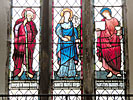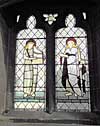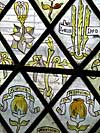 Coddington Coddington
All Saints
Glass
Click the numbers in the key plan for details of the items.
All the stained glass windows at Coddington church were made by Morris Marshall Faulkner & Co or by Morris & Co. Three windows (including the east window) are early 1865-9, and three more date from 1881-2.
Of the 20 cartoons represented in the panels one is unique, another is a first use and eight have been used seven or fewer times and could be considered rare. All the figures are set against silver-stained quarries.
South Aisle
The south-aisle contains three windows all filled with Morris & Co stained glass of 1881-2 - a pair of plate windows (each 2-lancets with quatrefoil above) and the larger east window (3-lancet lights, the central lancet with a cusped top, and with tracery of three quatrefoils above). The designs are by Morris, Madox Brown and Burne-Jones. The St Joseph (by Morris) and St Anne (by Madox Brown) are rare cartoons and the David in Armour (Burne-Jones) is a moderately-used cartoon.
1&2Pair of Windows, 1881
 St Elizabeth St Elizabeth
and St Anne |
 David and David and
Samuel |
The figures in the two stained glass windows are St Elizabeth / St Anne / Dove descending in the tracery and David / Samuel. Names are given below the figures, which stand against quarry grounds of daisies and tulips with wide borders of crowns and leaves/roses (the borders designed in the early 1860s by Philip Webb). The entry in the Catalogue of Designs, dated July 1881, names the glass-painters: Samuel by Dearle, David by Bowman (but the painters of Sts Anne and Elizabeth are not recorded).
L St Elizabeth (Ford Madox Brown, FMB 37a , without the boy John)
R St Anne (Ford Madox Brown FMB 57a) rose in vase held up in her R hand, book in L hand, white head-dress.
Tracery: Dove descending (probably adapted from a Philip Webb cartoon).
L David (Burne-Jones BJ 142) bearded in plumed helmet, breast plate and greaves, harping.
R Samuel (Burne-Jones BJ 177) old, in long robe, horn in L hand.
Tracery: Pattern-work.
- St Elizabeth FMB 37a was designed for and first used at Bradford Cathedral in 1863 (and used at least 8 times since). It was also used at Guernsey as Sarah in 1864; Wolverton in 1865; Llandaff Cathedral in 1866; Marple in 1873; Knaresborough in 1873; Winteringham in 1874; Middleton Cheney in 1880; and Coddington in 1881.
- St Anne FMB 57a was designed for Middleton Cheney in 1868, though it was not made until 1880. It was also used at Dedworth in 1873; Flockton in 1873; St Saviour's Leeds c1872 at Coddington in 1881.
- David Rex in armour BJ 142 was designed for and first used at Calcutta Cathedral in 1874 (and used at least 6 times since). It was also used at St Martin in the Bullring, Birmingham in 1877; Monkton in 1879; Coddington, Notts in 1881; Plymouth Emmanuel in 1881; Putney All Saints in 1898; St Andrew’s Grahamstown, South Africa in 1922.
- Samuel BJ 177 was designed for and first used at Llandaff Cathedral in 1868 (and used at least 19 times since). It was also used at Jesus College Cambridge (redrawn) in 1872; Knaresborough in 1873; Leigh in 1874; Tamworth in 1874 and 1925; Rotherfield in 1878; Middleton Cheney in 1880; Coddington Notts in 1881; St Andrew Keighley in 1881; Plymouth Emmanuel in 1881; Bolton Walmsley in 1889; Holy Trinity, Sloane Sq Chelsea in 1894-5; Cromer in 1894; Crescent St Montreal in 1901; St Mary, Merton (as Abraham) in 1907; Putney All Saints in 1910; Cheadle Royal Hospital in 1911; Corby in 1918; Burnmoor in 1919.
3  East Window East Window
The east window contains the figures of St Joseph, the Virgin Mary and St John, each named below, standing on grassy verdure and set against diamond quarry grounds. (The figures occupy relatively little of the window, and the silver-stained quarries are painted with either broomscods or rosettes of leaves with flower/fruit.)
The Morris & Co Catalogue of Designs, dated May 1882, gives the names of the glass-painters as: Mary Virgin and St John by Bowman; St Joseph by Dearle. The colouring of the triple window is exceptionally beautiful.
The cartoons used are listed below:
L: St Joseph, House of David (William Morris, WM 421) in red, with staff.
C: Mary Virgin (Burne-Jones, BJ 108) in blue with book and lily.
R: St John (Burne-Jones, BJ 422) in red with cup and serpent and gospel book ('In principio erat verbum et verbum erat apud Deum' - 'In the beginning was the Word and the Word was with God'.)
Tracery: Pattern-work.
- St Joseph WM421 was designed for and first used at Bradford Cathedral 1863. It was also used at St Stephens, Guernsey in a Jesse Tree in 1864, and at Coddington in 1882.
- Mary Virgin BJ 108 was also designed for and first used at Bradford Cathedral in 1863 (and used at least 14 times since). It was also used at St Mary’s, Antingham in Norfolk in 1865; Guernsey in 1865; Henley in Arden in 1865; Scarborough 1868?; The Lady Chapel, Dalkeith in 1868; Fawley c1868; St Martin's, Marple Cheshire in 1873; Sopworth 1873; The Sacred Heart, North Gosford c1875; Middleton Cheney in 1880, Coddington in 1882; Whitelands College, Putney 1886; Duxhurst 1909 and Deaconess House Wandsworth 1911.
- St John BJ 422 was designed for and first used at St Mark’s, New Ferry, Wirral in 1876 (and used at least 17 times since). It was also used at Coddington in 1882; Dedworth Church near Windsor in 1888; the large east window of Holy Trinity, Sloane Street, Chelsea in 1894-95; Ashton-Under-Lyne in 1896; Streatham in 1897; Dundee St Mary in 1897; Neston in 1901; Matlock in 1905; Denchworth, Oxfordshire in 1907; St Barnabus Kensington in 1909; Cheadle Royal Hospital in 1911; All Saints, Broomfield in 1913; Algeciras in 1916; Nelson in 1919 and 1921; Fatfield in 1921; Salisbury Australia 1928.
Chancel
4 Chancel South Window

The square-headed south window, which lights the choir benches and organ, contains two lights with cusped tops and tracery between. This window contains a unique William Morris St Cecilia design - the panel was probably the St Cecilia included in the firm’s display in the 1864 Exhibition of Stained Glass at South Kensington. The St Catherine cartoon has been used at least 11 times.
L: St Cecilia William Morris WM73a, wreathed, playing organ, sleeveless dress. Unique panel.
R: St Catherine William Morris WM332 wreathed, with open book in R hand, long sword pointing down in L.
Both figures are barefooted, standing on foreground of bricks; silver-stained quarry grounds with a diagonal design.
Tracery: Pattern work - Philip Webb note of May 1865: ‘Tracery for aisle window Coddington … 15s’ probably relates to this.
Inscribed:
In memory of Frances Spence of Tilworth, Yorkshire who died Decr. 3rd 1855 age 67.
Because I live ye shall live also. |
This was the first Mrs Thorpe's mother, whose own death soon after in 1868 provided the impetus for the Tower window, and perhaps also the reredos.
- St Catherine William Morris WM332 was designed for and first used at Middleton Cheney in 1865 and has been used at least 10 times since. It was also used at All Saints Jesus Lane Cambridge in 1865; Coddington in 1865; St Saviour Leeds in 1870; Jesus College Cambridge in 1873; Dedworth in 1873; Welton in 1877; Putney All Saints in 1878, Tadcaster in 1879; Irton in 1888; Dorchester in 1913.
The design is related to (but not identical to) the embroidery panel St Catherine, part of a series designed to decorate Red House (and later also used as a stained-glass cartoon). Our earliest stained glass was made at a time when Morris was forced to give up the projected scheme to create a colony of artists at Red House.
5 Chancel East Window
 East window: East window:
left light |
 East window East window
|
 East window: East window:
right light |
1865 Chancel E Window: 3 lights and tracery, with figures in 3 tiers in the side lights.
L top: St Peter William Morris WM173a, in cope, facing R.
L middle: St Stephen Burne-Jones BJ 149a.
L bottom: St Mary Magdalene William Morris WM171 with wreath in l hand, holding up vase.
C above: Christ on the Cross, with Mary Virgin and St John Burne-Jones BJ 126a without Angels; Sun and Moon above.
C below, in a small panel: Annunciation Burne-Jones BJ120a.
R top: St Paul William Morris WM70a, with sword in R hand, open illuminated book in L.
R middle: St James the Greater William Morris WM179a in pilgrim’s cap, staff in R hand, palm in left.
R bottom: Martha William Morris WM263, turbaned, keys on L wrist, holding up her robe.
All the figures stand on foregrounds of flowers, against silver-stained quarry grounds (with a diagonal design).
Tracery - Top, Seraph; other tracery lights, pattern work.
Inscribed:
In memory of James Thorpe of Beaconsfield who died November 4th 1843 age 52.
Blessed are the dead which die in the Lord. |
This James Thorpe was responsible for buying the estate at Coddington - his son became Church Warden, principal church and village benefactor, and de facto squire.
The Crucifixion design, with mourners Mary and St John, is here used without accompanying angels, giving an uncluttered and beautifully naïve effect. Classification of the early Morris Marshall Faulkner & Co Crucifixion designs is complex - many of them re-use the central Christ on the cross design and differ only in the accompanying mourners, angels and sun/moon motif.
Sewter states ours is the design BJ 126a first created for St Edmund's Hall Chapel, Oxford in 1863 (also adapted for Amington Church in 1864 as BJ 126b, for which Burne-Jones was paid £8).
Crucifixion BJ 126a was then used at Coddington in 1865; Tuebrook Liverpool in 1868; Bromham in 1870; Meole Brace in 1871; Ponsonby in 1877.
Crucifixion BJ 126b was used at Amington in 1864; Guernsey c1870; Marple 1869; St Michael Penkevil 1866.
Similar Christ-on-the cross designs can be seen at Catton 1866; St Winifreds, Hayward Heath in 1867, Llandaff Cathedral, Cardiff in 1867, St James Brighouse in 1870, Haltwhistle in 1872, the Vanderpoel window Saugerties New York in 1874, the Gordon Chapel Fochabers, Moray in 1876.
The particular mourning figures used at Coddington were first used in the St Edmund Hall College Chapel Crucifixion design of 1863.
As far as I know, our Mary design BJ 286a has only been used four times at St Edmund Hall; Coddington 1865; Haywards Heath 1867 (window destroyed 1962) and Brown Edge 1874. (Sewter's index does not record the Coddington use).
The St John design BJ 117 has been used at least eleven times - both with this crucifixion design and with other designs (as at Troutbeck and Llantrisant). (Sewter's index records 6 uses of BJ 117, not including the Coddington use - St Edmund Hall; Haywards Heath 1867; Haltwhistle 1872; Troutbeck 1873; Brown Edge 1874; Llantrisant 1874; Saugerties NY 1874; Fochabers 1876; Thornton 1876).
Above the cross, neatly fitted into the side lobes of the light, are the sun and moon, or ‘sol-luna’ which refer to the dual nature of Christ - the sun his divinity and the moon his humanity. In the Amington, Low Catton and Brighouse (1870, now at Cliffe Castle Museum) Crucifixions these same symbols are carried by angels. Sewter's index records 11 uses of the Catton Crucifixion cartoon, BJ 290-292.
In the small Annunciation panel Virgin’s features and hair may have been modelled on William Morris’s wife Janey. The poses of the two figures are similar to those in many famous renaissance paintings – by Fra Angelico, Leonardo Da Vinci, Botticelli and Ferrari. Latin speech scrolls and a vase of Madonna lilies separate the figures. The design was first used at Brighton (Church of the Annunciation) in 1865, then at Coddington (1865) and afterwards without speech scrolls at Haywards Heath (1868, now destroyed), and in Morris’s first American commission, the Vanderpoel Window in Trinity Church Saugerties, New York.
St Peter, dressed in Bishop’s robes and carrying the keys of Heaven and Earth, is a self-portrait by William Morris designed and first used for Middleton Cheney’s east window 1864-5 (and used at least 16 times since).
Very early uses of the cartoon are at St Nicholas Beaudesert in Henley-in-Arden 1864-5, here at Coddington 1865, Greenock North Church 1865; Guernsey 1865; All Saints Church, Jesus Lane, Cambridge 1866. Other uses include a tile panel at Peterhouse College, Cambridge.
Burne-Jones was paid £2 2s for his design of St Stephen (BJ149a) the first Christian martyr – you can see the stones used to kill him and the martyr’s palm in the design. It was first used in 1864 in a window at Bradford Cathedral (which cost £300) and at least 9 times since. Early uses include Coddington 1865, Greenock North Church 1865; Langton Green 1865; All Saints Jesus Lane Cambridge 1866; with other uses at Dalton 1868; Llandaff Cathedral Cardiff 1869; Bloxham 1869; Haywards Heath and Llanllwchaiarn c1870.
Mary Magdalene WM171 carries a wreath and the perfume bottle she used to anoint Christ’s feet. The cartoon was thought to have been designed c1863 for Bradford Cathedral. It was used at Coddington in 1865; and later at Scarborough St Martin-on-the-Hill in 1868 (a window that also includes the Virgin Mary in the south aisle window); Dalton in 1868; Sopworth in 1873; Leeds Mill Hill 1875; Edgmond 1876; Forfar 1881; Putney Whitelands College 1886; Putney All Saints 1890; Manchester College Oxford 1895.
St Paul WM70a was designed for and first used in 1864-5 in St Giles Camberwell – in this window (now destroyed) it appeared with the St John the Baptist design used in Coddington’s Tower window. It was also used at Coddington 1865; Dalton in 1868; Cardiff in 1869; Marple in 1870; Wooley St Peter in 1871.
St James the Greater (with pilgrim’s cap and staff and associated with the shrine of Santiago de Compostela) was probably chosen to honour the family name of the Thorpe patrons. The design (WM179a) was used seven times, at Bradford; Coddington 1865; Guernsey 1865; Farnham 1868; Cardiff 1869; Marple 1870; Haywards Heath 1871 (destroyed).
The first use of the cartoon was in the 1864 Chancel south window at Bradford, in which Burne-Jones’s St Stephen also appeared and the central Salvator Mundi was Albert Moore’s only cartoon for the firm. There is a drapery study for St James at Birmingham City Art Gallery. Morris’s account book stated ‘received £2 each for designing a beastly James and Jude’.
Martha, Mary Magdalene’s more domestic sister with her keys and raised apron, is design WM263. It was first used here at Coddington in 1865. Sewter says it was also used at Leeds St Saviour 1870; Liverpool Edge Hill 1873; Mill Hill Leeds 1875; Edgmond 1876. The design was later adapted to become ‘Autumn’ in the 1873 series ‘The Four Seasons’ which can be seen at Birmingham Museum and elsewhere.
Vestry
6East Vestry Window
The east vestry room is lit by a square-headed window opening, containing a 3-light window. Along the top is an ogee-shaped arcade, with tracery defining trefoil-shaped tops to the three lights. The window is filled with colourless glass, leaded in a diamond pattern of panes.
7North Vestry Window
The other vestry room is lit by two narrow lancet windows, filled with colourless glass, leaded in a diamond pattern.
North Aisle
8&9 North Aisle Windows
 Quarry glass in Quarry glass in
north aisle |
 Morris & Co. Morris & Co.
quarries |
The north aisle is lit by two square-headed windows of three and two lights, filled with silver-stained quarries. The newspaper report of the 1865 re-opening of the church mentions this stained glass: ‘The windows in the aisle are filled by Mr Thorpe with quarry glass from the firm of Messrs Baillie, Wardour St London.’ Those on the south side are inscribed with ‘Laus Deo’ - praise to God; those on the north ‘Alleluia’.
The displaced south quarries have found their way into the north windows over time, along with odd Morris & Co quarries (3 designs), which must have been supplied as spares for the 1881-2 windows.
Nave West
10&12 West Wall Windows
Two windows pierce the west wall of the nave - the larger is by the south-aisle, a window of two lights with shaped tops and quatrefoil tracery, filled with plain glass.
13No details.
Tower
11 Tower Lancet Tower Lancet
Probably the earliest of the re-used windows (and presumably also in situ). This small lancet-window by Morris Marshall Faulkner & Co depicts John the Baptist, in stronger colours than the other two early windows. Although Sewter thought it probably dated to 1865, the invoice has now been found, dated March 1869. It cost £6 10s plus 5s for packaging - a dedication plaque indicates it was a memorial to the first Mrs (Mary) Thorpe from her sisters Harriet and Jane Spence.
The pennant recalls the 1865 Tribes of Israel window at Middleton Cheney. This cartoon is rare and a gift from Mr M Manser of the William Morris Society enabled the glass to be thoroughly renovated in 1998.
- St John the Baptist (William Morris WM71a) - in red mantle over long hair shirt, R hand raised, holding banner with long pennant in L; quarry ground with silver-stained daisies; name below.
The cartoon was designed for and first used at Camberwell in 1865 (the window no longer exists, but there is a photo in the 1898 text by Aymer Vallance). It was also used at Guernsey in 1865; Coddington in 1869; Scarborough St Martin on the Hill in 1871-3; Knaresborough in 1873.
|